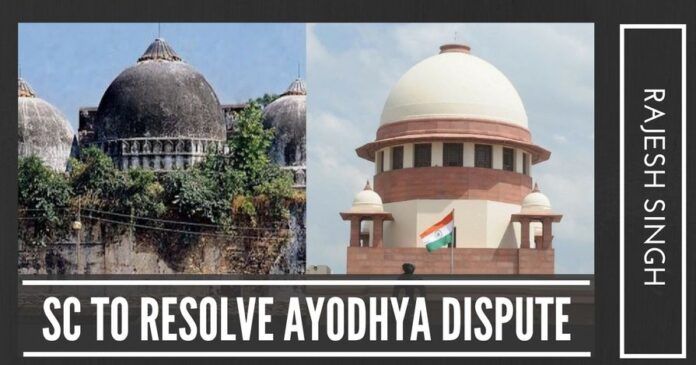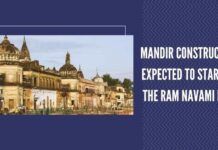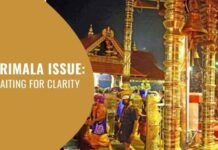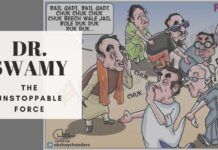
The archaeological evidence seemed to be going against the Babri mosque
When the All India Muslim Personal Law Board (AIMPLB) recently sacked one of its founder members for collaborating in an effort at an out-of-court settlement to the decades-old Ayodhya dispute, many eyebrows were raised. But the fact is that like-minded Muslim organisations have for long resisted attempts to arrive at an amicable agreement on the issue, whether helmed by private individuals or Governments. Let’s go down memory lane for a while to understand this.
At the next meeting, the BMAC asked for an additional six weeks’ time to peruse the evidence
The first major effort at reconciliation between two key and rival organisations — the Vishwa Hindu Parishad (VHP) and the Babri Masjid Action Committee (BMAC) — was made by the Chandra Shekhar Government during November 1990-March 1991, a good one year before the mosque was razed to the ground. A representative of the two groups met in the presence of the then Union Minister of State for Home Affairs. By then, the Government had narrowed the issue to just one specific question: Had the Babri mosque replaced a Hindu temple in existence earlier? Four historians who tagged along with the BMAC representatives insisted they be considered ‘independent’, to which the VHP justifiably protested. At the meeting, which happened in early December 1990, it was agreed that the two sides would provide evidence to the Government, which in turn would give photocopies of the same to the opposing sides. The evidence was turned over three weeks later and photocopies exchanged between the opposing parties. A month after that, both sides were asked to present a list of their experts on history, law, archaeology and revenue records, and a date for the next meeting was fixed.
But here came obstructionism from the BMAC. At the next meeting, the BMAC asked for an additional six weeks’ time to peruse the evidence. This was clearly a delaying tactic because one of the historians in the BMAC had earlier emphatically stated that there existed no evidence whatsoever of the pre-existence of a temple where the Babri mosque stood. The VHP saw the game and refused to relent. In turn, BMAC representatives did not turn up for the next meeting. It was back to square one.
It’s interesting to note that the BMAC’s historical evidence apparently consisted of just three papers, some of which were open to serious questioning. This explains why the organisation did not put out its material in the public domain, unlike the VHP which readily presented to the people its documents titled, ‘History Versus Casuistry: Evidence of the Ramjanmabhoomi Mandir Presented by the Vishwa Hindu Parishad to the Government of India in December-December 1990-91’. But the BMAC did try to discredit the then Government’s initiative through its camp historians, who claimed that the Centre had refused to accede to the demand to have ‘independent historians’ on the panel and that it was behaving like an umpire in a dispute over history to be fought (and decided upon) by litigants. This they attempted through what they called the ‘Ramjanmabhoomi-Babri Masjid: A Historians’ Report’.
What was it that prevented the BMAC to show willingness in expediting the matter? Why did it need a further six weeks’ time to study the evidence when it had already concluded on the basis of its previous studies that there was no evidence of a temple being in existence at the site of the Babri mosque? Was it because it had weak evidence? Or was it under pressure from extraneous sources to allow the dispute to fester?
KK Muhammad, then the Superintending Archaeologist, confirmed, I have visited the excavation near the Babri Masjid and seen the excavated pillars…
It was obvious that the BMAC and its supporters (which included the bunch of so-called independent historians) were uncomfortable with the emerging material from archaeological sources. This largely explains why those sympathetic to the cause began efforts to pre-empt any possibility of the pro-mosque lobby losing. The Indian History Congress, then dominated by Left-Liberals, adopted a resolution in December 1990, that the dispute be resolved by bringing the mosque under the jurisdiction of Ancient Monuments Act. In other words, it was to ensure that the mosque would no longer be disputed and would remain forever since there could be no litigation against it.
Meanwhile, the archaeological evidence seemed to be going against the Babri mosque-supporters. Towards the end of 1988, Professor BB Lal, who had served as Director General of Archaeological Survey of India (ASI), presented a paper in which he asserted that excavations had shown the presence of pillars dating before the mosque. This finding was upheld by at least a couple of other experts. KK Muhammad, then the Superintending Archaeologist, confirmed in the following words: “I have visited the excavation near the Babri Masjid and seen the excavated pillars… Muslims should respect the sentiments of millions of their Hindu brethren and voluntarily hand over the structure for constructing the Ram temple.”
But Muhammad’s advice was not to be followed. Instead, Left-liberal historians, much to the BMAC’s delight, sought to rubbish the inference. They first said that the presence of pillars around the mosque did not necessarily mean they were also beneath the mosque. Then they claimed that the brick pillars by themselves didn’t prove the existence of a temple at the site (‘it could simply have been part of some hall adjoining the mosque’!). They also floated the theory that the pillars could have been transported from elsewhere. They added that such pillars could have been part of some Buddhist structure. But it appeared even to these historians that they were stretching their arguments too far in the absence of real evidence. Thus, one among them later formulated a new line of argument: Even if “hypothetically speaking, some remains of a Ram temple were found below the Babri Masjid… the wrongs of the past cannot be rectified today”. Unfortunately for these ‘independent historians’ several academics who had no axe to grind, later endorsed the findings of BB Lal.
The next serious effort by the Centre at reviving the discussion between the VHP and the BMAC was made in October 1992 with PV Narasimha Rao as Prime Minister, and at a time when both these groups had hardened their respective positions and communal tensions were running high, especially in Uttar Pradesh and the rest of the northern belt. Both the organisations fielded nearly the same team of 1990-91. The new archaeological findings which seemed to go the VHP way were discussed. BMAC members dismissed the evidence as having been ‘planted’. They demanded that the VHP tone down its public campaign in favour of a Ram temple at the disputed site — which the VHP rejected. Two months later, the mosque was demolished; one month after the demolition, the Centre made a Presidential Reference to the Supreme Court under Article 143 of the Constitution of India. The single point of reference was: ‘Whether a Hindu temple or any Hindu religious structure existed prior to the construction of the Ramjanmabhoomi–Babri Masjid in the area on which the structure stood’.
With such ostrich-like attitudes demonstrated by the pro-mosque lobby, there never was going to be an amicable resolution
The BMAC and the ‘independent historians’ had rubbished the earlier archaeological findings of the ASI. The Allahabad High Court ordered fresh excavations, which were conducted between March and August 2003. The ASI excavated a total of 90 trenches across the four directions. The report that was subsequently prepared concluded thus:
“Viewing in totality and taking into account the archaeological evidence of a massive structure just below the disputed structure and evidence of continuity in structural phases from the 10th century onwards up to the construction of the disputed structure along with the yield of stone and decorated bricks as well as mutilated sculpture of divine couple and carved architectural members including foliage patterns, amalaka… are indicative of remains which are distinctive features associated with the temples of north India.” Needless to add, even this scientific finding was rejected by the ‘independent historians‘, with one of them calling it “an unprofessional document, full of gross commissions, one-sided presentations of evidence, clear falsifications and motivated inferences”.
With such ostrich-like attitudes demonstrated by the pro-mosque lobby, there never was going to be an amicable resolution. Events unfolding presently are an extension of that mindset. It is now left to the Supreme Court to settle the matter.
Note:
1. The views expressed here are those of the author and do not necessarily represent or reflect the views of PGurus.










